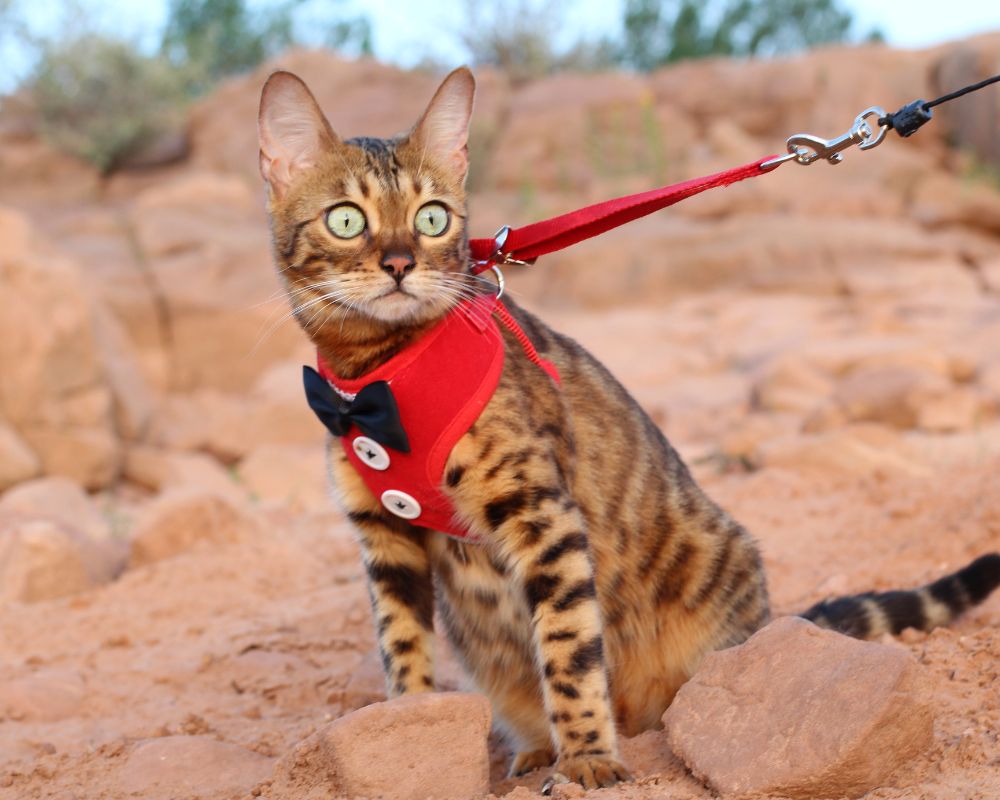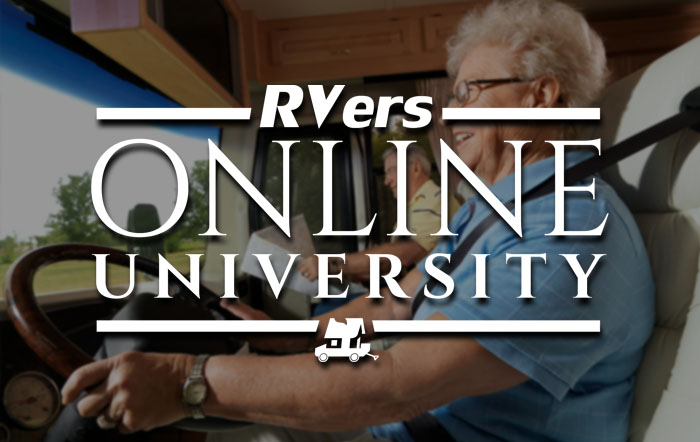If you’re planning to hit the road full-time in your RV or for an extended road trip and you want to bring along your feline friends, this article is for you.
Unlike dogs, cats are somewhat finicky creatures who don’t always adapt to change, moving houses, or loud environments well.
However, it is absolutely possible to acclimate your cat to your new RVing lifestyle and help keep them comfortable, safe, and happy on the road.
- 10 Tips for RV Travel With Cats
- 1. Acclimating Your Cat To The RV
- 2. The Litterbox
- 3. Preventing Escapes
- 4. Cat Safety On Travel Days
- 5. Creating Safe Hiding Spots For Your Cat In Your RV
- 6. Veterinary Care On The Road
- 7. Maintaining a Consistent Routine
- 8. Safe Outdoor Exploration
- 9. Temperature Control and Monitoring Inside The RV
- 10. Engaging and Stimulating Environment
10 Tips for RV Travel With Cats
From acclimating your cat to figuring out where to place the litterbox to learning how to keep them safe and happy, here are our top 10 tips for RV life and travel with your feline friends.
1. Acclimating Your Cat To The RV

Embracing the RV lifestyle with your feline friend can be a wonderful adventure, but it’s essential to ensure your cat feels at home in this new environment.
If you can, begin by introducing your cat to the RV while it’s stationary. This gradual approach allows your cat to explore and familiarize themselves with the space at their own pace.
Start with short, supervised visits inside the parked RV. Bring along their favorite toys, a comfortable bed, or a blanket with familiar scents. These familiar items will help your cat associate the RV with comfort and safety. During these initial visits, observe your cat’s behavior and offer plenty of reassurance and treats to create positive associations.
If you are planning a full-time RV life with your feline companions, consider living a month or two stationary in the RV so your cat can become accustomed to its new home before you start moving around. Then, gradually start taking short trips so your cat can get used to the process and also the knowledge that they will always return to their stable, comfy bed at the end of the day.
Remember, every cat is unique, and some may take longer to adapt than others. Patience and understanding are key. Your cat’s comfort is paramount in making the transition to RV living a smooth and enjoyable experience for both of you. With time and encouragement, your cat will soon see the RV as their home.
2. The Litterbox
Finding the perfect spot for the litter box in your RV is crucial for both your comfort and your cat’s. Choose a location that’s quiet, accessible, and away from your living and dining areas, ensuring privacy for your cat while minimizing odors and mess in communal spaces.
Under benches, in the bathroom, or in a corner of the bedroom are popular choices. If you have multiple cats, it’s wise to have more than one litter box to prevent territorial disputes and maintain cleanliness. Consider using a covered litter box to contain litter scatter and odors, especially during travel, making your RV experience more pleasant for everyone.
If you have a fifth wheel, a popular spot for the litterbox is in the storage bay with a cat-sized hole in the stairs that allows them easy access to their litter. It keeps it out of sight and helps cut down on odor in such a small space.
3. Preventing Escapes
Ensuring your cat doesn’t escape from the RV is a vital aspect of their safety. Start by thoroughly checking that all potential exit points, such as doors, windows, and vents, are secure. Cats are curious and can squeeze through surprisingly small spaces, so it’s important to be vigilant.
Invest in robust screens or childproof latches for added security. These can provide ventilation while keeping your cat safely inside. Be mindful every time you open the door; a cat can slip out quickly and unnoticed. Training your cat to stay away from the door can be beneficial. You can use treats to reinforce staying back or in a designated area when the door is opened.
It’s also a good idea to have your cat wear a collar with an ID tag at all times, and ensure they are microchipped with up-to-date contact information. This way, if an escape does occur, there’s a better chance of a safe and speedy reunion. Remember, prevention is key, and a little preparation goes a long way in keeping your feline friend safe in your RV.
4. Cat Safety On Travel Days
Travel days in an RV require special attention to your cat’s safety, especially in a motorhome. It’s crucial to securely confine your cat in a carrier or harness while the vehicle is in motion. This not only ensures their safety during sudden stops or maneuvers but also protects the driver from potential distractions. Choose a carrier that is well-ventilated, comfortable, and secure, placing it in a location where it won’t shift during travel.
It’s important to emphasize that cats should never be left in a travel trailer or fifth wheel while it’s being towed. These areas can become unsafe environments for pets due to temperature fluctuations and lack of stability. Instead, your cat should always ride in the tow vehicle with you. In a car or truck, secure the carrier with a seat belt or place it in a stable spot.
Remember, your cat’s safety on travel days is as important as your own. Taking these precautions ensures a stress-free journey for both you and your feline companion, making your RV adventures enjoyable and worry-free.
5. Creating Safe Hiding Spots For Your Cat In Your RV
In the ever-changing environment of RV life, providing safe and familiar hiding spots for your cat is essential. One effective strategy is to use their carrier as a dual-purpose space – both as a bed and a safe zone. Place a comfortable cushion or a blanket that smells like home inside the carrier, and keep it accessible in a quiet corner of your RV. This setup encourages your cat to view the carrier as a cozy, secure retreat rather than just a travel enclosure.
By spending time in the carrier under stress-free conditions, your cat will associate it with feelings of safety and calm. This association is invaluable on travel days, as it significantly reduces anxiety and fear commonly associated with being placed in a carrier. Additionally, create other hiding spots in the RV, like under furniture or in small cubbies, where your cat can retreat to feel secure. These small sanctuaries provide comfort and a sense of control to your cat, enhancing their overall well-being while on the road.
6. Veterinary Care On The Road
Maintaining your cat’s health is a top priority during RV travels. Before you hit the road, consult with your home veterinarian about your travel plans. They can provide advice on emergency care and may offer telehealth services for remote consultations while you’re away. This can be invaluable for continuity of care, especially for cats with ongoing health issues.
Always carry a copy of your cat’s medical records, including vaccination history and any prescriptions. These documents are crucial in case you need to visit a new vet on the road. Research veterinary clinics and emergency animal hospitals along your route and at your destinations, noting their contact information and hours of operation.
For extended or full-time travels, consider getting recommendations for reputable veterinarians in the areas you’ll be staying. This preparation ensures that, no matter where you are, you’re ready to address any health concerns that may arise for your feline companion, keeping them healthy and happy throughout your RV adventures.
7. Maintaining a Consistent Routine
Cats thrive on routine, and maintaining consistency is key to their well-being in an RV. Try to stick to regular feeding, play, and cuddling times similar to those you had at home.
This familiarity helps your cat feel secure amidst the changing environments of RV travel. Keep their favorite toys and a piece of familiar bedding on hand to reinforce a sense of normalcy.
Also, be consistent with litter box cleaning and placement within the RV. A predictable routine not only comforts your cat but also makes it easier for you to monitor their health and behavior while on the road.
8. Safe Outdoor Exploration

If you choose, you can start leash training your cat to enjoy some enrichment time outdoors. However, this should always be done under close supervision and with great vigilance for your cats stress levels.
Your cat should never be left to roam freely outdoors, and never ever leave your cat on a leash unsupervised. It can get tangled and injure or strangle itself, as well as become prey for local wildlife.
If you do consider leash training, be sure your cat has an up-to-date microchip and consider a GPS collar. Even the most “escape-proof” harness can be wiggled out of by a scared cat, no matter how snug you think it is, due to the way they can move their shoulders and legs. Also, never leash train with a collar. Always use a harness to protect their delicate neck.
9. Temperature Control and Monitoring Inside The RV
Maintaining a stable and comfortable temperature inside your RV is vital for your cat’s safety, especially when you’re out running errands or shopping. Extreme temperatures can be hazardous, so it’s important to use air conditioning or heating as necessary.
Invest in a WiFi or cell signal enabled temperature monitoring device; these gadgets allow you to check the internal temperature of your RV remotely through your phone. This technology provides reassurance that your cat is in a safe, comfortable environment, even when you’re not physically there. Always ensure your RV is properly ventilated and that your cat has access to fresh water to stay hydrated.
Here are some RV temperature monitoring devices that use cell signal:
- Waggle RV Pet Safety Temperature and Humidity Sensor (No Wifi needed, uses Verizon network)
- MarCell Temperature & Humidity Monitor (No Wifi needed, uses AT&T Network)
10. Engaging and Stimulating Environment
Keeping your cat engaged and stimulated is important in an RV setting. Many RVers go the extra mile by creating ‘catios’ – safe, enclosed outdoor spaces attached to their RVs. These catios allow cats to enjoy the outdoors without the risks of roaming free. They can bask in the sun, watch birds, and enjoy fresh air, all within a secure environment. Inside the RV, provide a variety of toys, scratching posts, and perhaps a window perch for bird watching. These elements keep your cat mentally and physically active, ensuring they are content and stimulated throughout your travels.
Do you like this? Pin it on Pinterest!













6 Responses
Great info . My cat buddy has been a full time rv cat for 8 years and seems to love it .
That’s great!
Great information. We travel with our 5 cats in our motorhome many times each year. If it has been a while since their last trip, we spend a night or two with them in the RV in our driveway before we leave on the trip. And we have photos of each of them mounted in the RV and all their vital veterinary records with us. Each has a registered microchip, and a collar with the home information as well as a handwritten tag with our current campground information. They travel well. And we love having them with us.
Thank you for sharing your experience traveling with your cats!
We live in the country and my cat is an indoor outdoor cat and sometimes brings some disgusting things. we want to go on a trip for at least a couple of weeks and I am so worried about him trying to escape. these tips
have been helpful but I was thinking about there’s a huge dog cage that is collapsible that maybe I can put outside for a little while we were stopped so he can see what’s going on I am so scared to death to leave
Hi Sherry, we agree that you don’t want to lose your kitty while you are on your trip and using a collapsible dog kennel is a great idea to keep your kitty safe!